Hardenbergia violacea



Woody
Stems and branches with a woody texture commonly associated with shrubs or perennials.
Climbing-twining
A plant that climbs using tendrils or twines around a structure.This vigorous twining plant has slender woody stems that climb over structures and plants forming a dense cover. It has dark green lanced-shaped leaves and the small purple pea-shaped flowers appear in a pendant raceme during spring.
Hardenbergia violacea (Schneev.) Stearnis is naturally found from Queensland to New South Wales, Victoria and South Australia. It grows in coastal or inland, and in mountainous regions amongst woodlands or on rocky hillsides from sea level to an altitude of 1,200 m (3,937 ft). It prefers a well drained moderately fertile moist sandy-stony to clay loam that is slightly acidic to neutral, with a pH range from 6.5 to 7.5. It grows in a sunny to semi-shaded open to exposed position and is drought and slightly frost tolerant with a minimum temperature of -6ºC (21ºF). It is also rabbit and deer resistant and tolerates hot dry positions, but dislikes waterlogged soil.
Sarsaparilla is grown for its prolific flowers and its climbing habit. It is grown over lattice or on wire fence for screening and is used as a ground cover or spill-over above retaining walls. It is quick growing establishing in 1 to 2 years from seed but may be short lived to 15 years. It is suitable for coastal and inland regions and is also planted in patio pots and planter boxes. It has a low water requirement once established (Scale: 1-drop from 3), responding to mulch and an occasional deep watering but will tolerate dry conditions.
I.D. 132
UK hardiness zone H2
Climate zones 8 - 24
USDA Zone 9-11
Hardenbergia (hard-an-BERG-ee-a) violacea (vee-o-LAH-see-a)
Genus: - Hardenbergia– named in honour of the Austrian Countess Franziska von Hardenberg
Species: - violacea: meaning (violet-coloured) referring to the colour of the flowers

Cultivars
'Alba'
This plant has white flowers.
'Flat White'
This variable plant forms a prostrate mat-like habit and produces white flowers. It tolerates a range of well drained soils from sea level to the adjoining mountains. This plant was released commercially by the Mt Annan Botanic Gardens in Sydney Australia and is found naturally from Queensland to Tasmania. It is commonly grown as a ground cover on slopes.
'Happy Wanderer'
This plant has larger leaves and flowers with a compact habit.
'Mini Ha Ha'
This plant has a dwarf habit.
'Rosea'
This plant has pink to rosy- lilac flowers
Fabaceae (fab-AY-see-ee)
Leguminosae and Papilionaceae are alternative names for this large family. They may be trees, shrubs, climbers and herbs.
Distribution
These plants are found in tropics to temperate climate zones with 12,000 species worldwide.
Diagnostic features
The leaves may be compound (pinnate or foliolate), simple or reduced to phyllodes, normally having stipules and commonly arranged alternately.
The inflorescence is a raceme, spike or in heads that are terminal or axillary, and may be a panicle that forms a psudo-umble.
The bisexual flower is composed of 5 imbricate petals, upstanding upper petal (standard) with two smaller lateral petals (wings) and two lower petals that may be fused forming the (keel).
There are ten stamens, which are free and enclosed by the keel with anthers that may be simular or different
The superior ovary has one carpel with normally one cell and the style is upturned, normally bearded.
The fruit is a legume that is normally dry and contains many seeds. These pods may be woody, papery or winged, which are covered in bristles, warts or hairs.
The seeds have a tough coat and are round or kidney shaped. These seeds have a long viability life and require scarification before germination.
Note:
Many of these plants have showy flowers and are good garden specimens; quick growing but short lived. These plants are of great economic importance supplying food and fodder for grazing animals.
Plant use:against a sunny wall, arid garden, butterflies, bushland settings, commercial sites, coastal or inland regions, containers, bright conservatory, heated glasshouse, dense screening, embankments, erosion control, garden trellis, ground cover, over structures, small gardens, suitable for California, Florida, Mediterranean, wire fencing
This plant tolerates between USDA zones 9a to 11a and grows to 2 m (6 ft)
Fahrenheit 20º to 45º F
These temperatures represent the lowest average
Celsius -3.9º to 7.2º C
Attention
This plant was last revised on the 12/07/2018
All photographs and data are covered by copyright. Apart from any fair dealing for the purpose of private study, research, reference or review, as permitted under the Copyright Act, no part including images and text may be reproduced by any means without written permission. The information presented in the map is only indicative and may contain errors and omissions. All inquiries should be addressed to sales@plantfile.com attention Peter Kirkland.

Simple
The leaf that is not divided.
Lanceolate
Broadest at the centre, three or more times long as broad (Lance-shape).
Alternate
Leaves are arranged alternately along the stem.
Entire
A leaf margin with no irregularities (smooth).The dark green leathery textured variable leaves are ovate to narrow-lanceolate up to 100 mm (4 in) long by 10 mm (3/8 in) to 50 mm (2 in) wide with a pale green underside. The apex is acute to acuminate and the short petiole to 10 mm (3/8 in). The upper surface has prominent reticulate venation.

Papillionate
Forming a pea shaped flower.
Raceme
An inflorescence forming along a central stem of indefinite length with flowers having there own stems.| Jan | Feb | Mar | Apr | May | Jun |
| Jul | Aug | Sep | Oct | Nov | Dec |
The 8 mm (1/3 in) long pea-shaped flowers have a purple standard with a yellowish spot and the wings are attached to a yellow claw. There are up to 30 flowers arranged in a cascading raceme that appear profusely in from late winter to early summer.

Legume
This dehiscent or indehiscent fruit has one or several seeds in a unicarpellate ovary. Commonly referred to as a pod. "| Jan | Feb | Mar | Apr | May | Jun |
| Jul | Aug | Sep | Oct | Nov | Dec |
The 50 mm (2 in) long flat grey brown pod contain 6 - 8 hard coated seeds that are up to 4 mm (1/8 in) long. The seeds are viable but the plant may be reproduced vegetatively. If ingested it may cause stomach upset and contact with the sap may cause skin irritation.

Sarsaparilla is grown for its prolific flowers and its climbing habit. It is grown over lattice or on wire fence for screening and is used as a ground cover or spill-over above retaining walls. It is quick growing establishing in 1 to 2 years from seed but may be short lived. It is suitable for coastal and inland regions and is also planted in patio pots and planter boxes.
Note:
This plant tolerates a light or hard prune and may be cut down to ground level bi-annually.
Sow fresh seed during spring in a well drained but moist media and maintain a temperature of 19º to 27º C. (66º to 81º F). The seeds need to be scarified or briefly immersed in boiling water before sowing to break the dormancy. The seeds have a long viability period.
Take soft tip cuttings of cultivars during growing period.
Propagation by Seed (General)
Germination
In order for a seed to germinate it must fulfil three conditions.
1. The embryo must be alive (a viable seed).
2. The seed must have no dormancy-inducing physiological, physical or chemical barrier to germination; also the seed must be nondormant.
3. The seed must have the appropriate environmental requirements, water, temperature and oxygen.
The interaction between these requirements and dormancy is complex which may lead to different environmental requirements that avoid the dormancy of a seed.
Sowing Seeds in Containers
There are two general methods for germinating seeds.
1. Sowing seeds in a flat or germinating bed, through which seedlings are pricked-out then, transplanted into another flat with wider spacing or directly to an individual pot.
2. Sowing seeds by placing them in to flats with the appropriate spacing or into individual pots.
This method is normally carried out with medium to large seeds such as woody plants and plants that are difficult to transplant.
Seedling production normally occurs in a greenhouse / glasshouse, cold frames and on hot beds.
Method of Seed Sowing
Fine seed is sown in pots or flats that are no deeper than 70 to 80 mm. using a sterilised well-drained media (soil). Fill the container to 20 mm from the top and sprinkle sieved peat to 3 mm depth.
Press the media down level then firm with a piece of timber and then thoroughly moisten.
Mix the fine seed with washed sand and then sow thinly on the surface. These may be lightly covered with sand.
Larger seeds may be covered with media or a hole is dibbled and the seed is placed in the media.
Watering Methods
For watering you may either mist the containers from above or place the container in tepid water and allow the water to raise through the pot to the surface of the media, then drain away and do not fill to the top of the container.
Place a piece of glass over the pot and store in a protected warm environment (glasshouse).
Seeds germinate best in darkness so shade the containers if in direct sunlight.
After the seedlings have sprouted remove the glass and ease the seedlings into direct light.
When the seedlings are large enough prick them out then transplant into larger containers and place them in a shade-house to harden off.
Many seeds have different methods of seed preparation for germination such as nicking or cutting the seed coat to allow water penetration, also placing seeds in hot water and allowing it to cool off.
This is particularly important as it is softening the seed coat.
Asexual Propagation (Cuttings general)
Propagation from cuttings is possible because every cell of a plant containers the genetic information to create an entire plant.
1. Reproduction occurs through the formation of adventitious roots and shoots.
2. The uniting of vegetative parts with budding and grafting.
3. Taking stem cuttings and layering is possible due to the development of adventitious roots
4. Root cuttings can form new shoots then it is possible to join roots and shoots to form a new plant.
5. A new plant may be formed from a single cell in an aseptic culture system, (cloning).
It is important to propagate vegetatively as this form of cloning retains the unique characteristics of the cultivars or where particular aspects of a plant may be lost if propagated by seed.
Equipment Required for Taking Cuttings
1. A sharp knife that is not too large or a razor mounted in a handle.
2. Good pair of sharp secateurs that is clean.
3. A dibbler to make a hole in the media and allow the cutting to be placed in.
4. Propagation structures that are either a timber frame with glass or polyethylene cover or a glasshouse.
The object of the structure is to create an environment where the temperature and humidity can be controlled. This can be achieved with a simple cover over a pot with a wire frame and plastic.
This stops the draughts and maintains humidity.
5. A hotbed is a useful item as many plants root more quickly if the media is slightly warmer.
Bottom heat is obtained from thermostatically controlled heating cables that are running under the media.
6. Misting systems are of great benefit to cuttings as the regulated fogging with water inhibits the cuttings from drying out and as a result the cuttings may be grown in full sun.
This results in faster root development that is less subject to diseases by fungi and bacteria.
7. Rooting mediums
The rooting medium must be well drained, sand may be used as long as it is thoroughly washed and leached of all salts. It is very well drained and it is excellent for cutting that root up quickly. Equal parts of sand and peat moss have good results for cuttings, which are left for a period of time to allow the roots to form.
Vermiculite and perlite are also used as a well-drained rooting media but has the same disadvantage as sand having no nutrients. The cuttings must be potted up as soon as the roots developed, or a light application of liquid fertiliser can be applied.
Types of Cuttings
Stem cuttings
These are the main types of cuttings.
1. Softwood cuttings
These cuttings are taken from young growth on side shoots and tip growth.
2. Semi hardwood cuttings
These cuttings are taken from wood that is firmer and semi ripe usually during mid summer.
3. Hardwood cuttings
These cuttings are taken from mature wood normally towards the end of the season.
4. Root cuttings
Cut sections of roots to obtain new plants during late winter to early spring.
5. Leaf cuttings
Cut the leaf blade in order to obtain new plants during the growing period of the plant.
Cutting preparation
Hardwood cuttings
When taking hardwood cuttings remove the leaves and in semi hardwood reduce the number of leaves by half. Cut the wood straight across just below a node or joint. Hardwood cuttings are normally between 100 to 760 mm long and may have either a heel of the older wood attached to the base, or a short section of the older wood at the base. These cuttings are prepared during the dormant season from late autumn to early spring and are made up from previous season's growth.
This type of cutting is used for woody deciduous plants such as Crepe Myrtle, Rose rootstocks and some fruit trees.
The cuttings should be healthy wood with ample supply of stored food as to nourish developing roots, shoots and placed in the rooting media with the aid of a dibbler stick.
Softwood cuttings
The cuttings for softwood should be 60 to 130 mm long and be of material with enough substance as to not deteriorate before the new roots appear. Cut below a node and retain the leaves on the upper portion. Place in a well-drained media and maintain a high humidity.
Soaking the cuttings and leaving them standing in water for long periods is undesirable.
Herbaceous cuttings
These cuttings are taken from succulent plants such as Geraniums and Coleus. The cutting should be 70 to 130 mm long with leaves retained on the upper end. As in softwood cuttings these require an environment of high humidity. Some fleshy cuttings ooze sap and may require a drying period for a few hours before being placed in the rooting media.
Leaf cutting
In these cuttings a leaf blade and petiole or part off is used to raise a new plant. The original leaf doses not become a part of the new plant as roots and shoots appear from the base of the leaf. In some cases roots appear from the severed veins.
Leaf-Bud cuttings
These cuttings incorporate a leaf, petiole and a small piece of the stem. These cuttings are an advantage where the plant uses the axillary bud at the base of the petiole for new shoot growth and maximises available propagation material, as each node will produce a new plant.
As in softwood cuttings these require an environment with high humidity and warmth.
Root cuttings
These cuttings are best taken from younger plants during late winter to early spring prior the new season's growth unless the dormant period is during summer.
Trim the roots as they are dug up, to maintain polarity cut strength at the crown end and a slanted cut at the distal end (away from the crown).
Root cuttings of small plants are placed in flats in lengths of 20 to 50 mm and laying horizontally on the surface of the soil. These may be lightly covered with sieved sand or media, watered and then placing a piece of glass or polyethylene over the container till roots / shoots appear.
Fleshy root cuttings
These cuttings should be 50 to 75 mm long and placed vertically in a well-drained sand media.
Keep the polarity correct and when the roots develop transplant the cuttings into a separate container.
Large root cuttings
These cuttings are 50 to 150 mm long are tied up in bundles and placed in boxes of damp sand, sawdust or peat for about three weeks at a temperature of 4. 5 deg C. When taken out they should be planted in a prepared bed 50 to 80 mm apart with the tops of the cuttings level with or just below the soil level.
PEST
NAME
Painted Apple Moth
Teia anartoides
ORDER
Lepidoptera
FAMILY
Lymantriidae
Description of the Pest
Adult males are 25mm long and have a 25mm wingspan, with brown forewings and yellow hindwings with black edges. Females are also 25mm long, but wingless. Larvae are furry brown caterpillars, up to 30mm long, with four prominent tufts of reddish brown hair behind the head, and two horn-like tufts of black hair projecting forward. The caterpillar's hair may cause skin irritation.
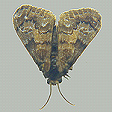
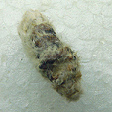 Wingless Female
Wingless Female
Appearance and Distribution of the Pest
An Australian native, most commonly found in temperate and subtropical regions. Originally known as the painted wattle moth, feeding exclusively on acacias, it has adapted to feed on apples and other species.
Life Cycle
This insect has a Holometabolous life cycle, ie. When metamorphosis is observed during the pupal stage.
Larvae pupate in loosely woven cocoons; eggs are laid on the empty cocoons.
Period of Activity
May be active all year, particularly during the cooler months.
Damage Caused
Larvae may skeletonise leaves; small plants may be defoliated. Because females are flightless, infestations are localised.
Susceptible Plants
A wide range of plants are affected, including apples, Acacias, Melaleucas, Grevilleas, and many exotics. Some fern species are also attacked.
Rosa species leaves are attacked by larva.
Cultural Control
Remove small infestations of larvae and cocoons by hand.
Biological Control
None known.
Chemical Control
Maldison, Carbaryl or other contact pesticides are effective; a wetting agent is necessary to penetrate the larval hair.
Note
Always read the label for registration details and direction of use prior to application of any chemicals.
PEST
NAME
Leaf Hopper (General)
Various Leaf Hopper Species
ORDER
Hemiptera
FAMILY
Eurytomidae
Description of the Pest
Generally hopper grows up to 15mm in length, with "A"-shaped folded wings that give it a characteristic triangular cross-section. The adults often have bright coloured markings and the nymphs conjugate in colonies. Adults can fly but will hop away immediately if disturbed and both nymphs and mature hoppers have piercing and sucking mouth parts.
The Passion Vine Hopper (Scolypopa australis) has clear triangular wings that have brown margins and black bands. The nymphs are wingless and white with tufts of hair on the end of the abdomen.
The Green Leaf Hopper (siphanta acuta) looks triangular with its steeply folded wings and can grow to 10mm long. The adults are generally a solitary feeder but the nymphs congregate on shoots.
Appearance and Distribution of the Pest
The adults and nymphs are present throughout the year in tropical to warm temperate regions and are dispersed by flying.
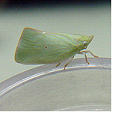
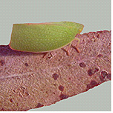
Life Cycle
These insects have a Hemimetabolous life cycle, ie. When the immature nymphs resemble the adults.
Females deposit eggs in slits they make in the bark or on the leaves of the host, and several generations may appear annually on the same plant.
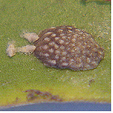 Egg and Nymph
Egg and Nymph 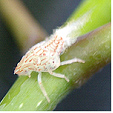
Damage Caused
Nymphs and adults are gregarious, and both stages may be found on host plants at the same time. If large numbers attack young new growth, sucking sap from leaf petioles and young stems, the host plant may become stressed. Severe infestations may weaken and eventually kill the plant with dieback and distorted leaves.
The nymphs exude a sweet secretion, which is attractive to ants that attend and protect the colony. The honeydew also causes sooty mould to occur as a secondary problem. Some species produce toxic saliva that kills the effected plant tissue; other species carry plant viruses.
Susceptible Plants
Most Eucalyptus, Acacia and Casuarina species are attacked by a variety of leafhoppers. Many other Australian native and ornamental plants are attacked.
Acer species are attacked by the leaf hopper (Alebra albostriella) which lays eggs under the bark causing minor swelling. Acer platanoides is particularly venerable.
Callistephus and Aster species are attacked by the Leaf Hopper (Macrosteles fascifrons) that generally causes little harm to the plant but transmits Yellow Disease, a viral infection.
Fern species are attacked by several types of leaf hopper, particularly the Passion Vine Hopper (Scolypopa australis). New fronds become deformed or misshapen as the insect sucks the sap causing dead patches to appear.
Parthenocissus species are attacked by the Green Leaf Hopper.
Rosa species are attacked by the Rose Leaf-hopper (Edwardsiana rosae), nymphs feed on the underside of leaves causing white blotches.
Sorbus aucuparia is attacked by the Japanese Leaf Hopper (Orientus ishidae) which causes the leaves to form a brown blotches with yellowish margins.
Cultural Control
Improving the culture of the host species may assist in maintaining vigorous growth, to minimise shock from infestations. It may be possible to remove them by hand, from young trees, using a small butterfly net if you are lucky.
Biological Control
Controlled by natural predation and the Green Leaf Hopper causes little harm and control is unnecessary.
Chemical Control
Under normal circumstances, it is impractical and unnecessary to treat mature trees however, hoppers on young plants may be treated with a contact insecticide. Note
Always read the label for registration details and direction of use prior to application of any chemicals.
PEST
NAME
Bag Shelter Moths
Various Bag Moths Species
ORDER
Lepidoptera
Description of the Pest
There many caterpillars that constructs a shelter that they live in and also acts as protection from predators. These caterpillars feed solitary or are gregarious emerging at night to feed. The caterpillars (larva) have chewing mouth parts.
Bagworm (Thyridopterix ephemeraeformis) adult is a moth that produces caterpillars that construct a small elongated shelter from pieces of the host's leaves and enlarges to 80mm long, as the lava grows. The eggs overwinter in an old female bag and many plants are attacked such as Thuja and Abies species.
Bluegrass Webworm (Crambus teterrellus) is the larvae of the closed winged moth. Deposited bead-like eggs hatch in 10 days and the emerging lava feed on the leaves of Turf Grass. They then construct a silken tunnelled nest close to the soil and disguised with soil, leaf fragments and droppings. The larvae pupate in a cocoon under ground for 14 days. Infested lawns such as Stenotaphrum secundatum (St Augustine) have a ragged appearance and areas may die off completely.
Forest Tent Caterpillar (Malacosoma disstria) are bluish with white diamond-shaped spots along its back, feeding solitary on leaves and unlike the Eastern Tent Caterpillar nests are not built by binding twigs together, but by surrounds a single branch.
Juniper Webworm (Dichomeris marginalla) is a small larva to 12mm long and is brown with reddish brown longitudinal stripes. They form bags by webbing twigs and needles and appear during summer. The eggs are laid by a female adult moth with a wing span of 10mm and the immature larvae overwinter.
Procession Caterpillars or also known as Itchy Caterpillar (Ochrogaster contraria) is a fleshy caterpillar that grows up to 50mm long and is named because of its procession habit when moving about head to tail. It appears banded in reddish brown stiff hairs that are long and irritate skin on contact. The adult brown moth has a wing span up to 50mm across with two spots on its forewings.
Larva constructs large obvious shelters or bags using the twigs and leaves towards the end of the branches. These bags have some stiff hairs that cause irritation, old casts and have a mud brick-like appearance.
Tentmaker (Ichthyura inclusa) adult female moth is grey wings that are white striped and produces a black larva with yellow stripes. The larvae construct silken nests by binding twigs together and feed on the surrounding leaves. Commonly found in Populus species. A simular caterpillar The Eastern Tent Caterpillar (Malacosoma americanum) is found on Cherry trees.
Webbing Caterpillar is up to 25mm long with numerous black hairs along its body and constructs shelters that incorporate stems and leaves, becoming larger as the larvae grows. The silk ties are littered with debris and excrement. The adult moth is greyish with small markings on the wings.
Life Cycle
These insects have a Holometabolous life cycle, i.e. an egg, larval, pupal and adult stage
The insect commonly pupates inside the bag, some pupate in the soil.
Distribution of the Pest
Larvae are active from mid summer through autumn, regardless of the climatic conditions.
They are found throughout coastal and inland Australia but the species vary with the climatic environment.. The moths fly to new areas aided by the wind and larva of certain species walk to a new host when the old one is depleted of food.
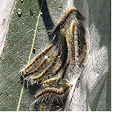 Gregarious larvae
Gregarious larvae 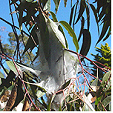 Typical bag shelter
Typical bag shelter
Period of Activity
Larvae shelter in the bag, where they feed during the day; they leave their shelter to continue feeding at night on the surrounding foliage.
Damage Caused
Larvae eat the leaves of shrubs or trees and a heavy infestation can cause complete defoliation. Ugly bags hang or are wrapped around the plant sometimes in large numbers. The shelters can be up to 300mm across and are constructed of twigs and leaves that are curled or joined together with silken thread, commonly look unattractive.
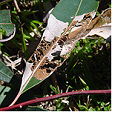 Leaves damaged by the larvae
Leaves damaged by the larvae
Susceptible Plants
A wide range of plants are attacked by these moths and include Brachychiton , Acacia, Baeckea , Beaufortia, Juniperus, Kunzea, Leptospermum, Melaleuca and Syncarpia species. The larva nest in the host plant or at the base and normally feed at night.
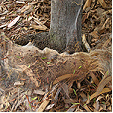 Nest at base of Acacia spp.
Nest at base of Acacia spp. 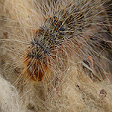 Hairy caterpillar
Hairy caterpillar
Acer, Betula, Quercus and Populus species are susceptible to the Forest Tent Caterpillar.
Cotoneaster species are attacked by Webworm (Cremona cotoneaster) lava which skeletonises the leaves.
Turf grasses are susceptible to an infestation of Sod Webworm (Herpetogramma licarsisalis). It is a sporadic pest that appears from late summer to autumn. The adult is moth is grey-brown with black spots and has wings are up to 25mm across with transverse dark wavy lines. It flies during the night depositing eggs. The larva (caterpillars) feed on the leaves and construct a silken nest close to the ground where they live out there lives. When fully fed the larvae are up to 25mm long, green brown with dark spots displayed on its body.
Control
Cultural Control
Cut bags from the tree during daylight and destroy.
Use gloves as some bags and larvae are armed with irritating hairs.
Biological Control
Birds and lizards help keep numbers down, but these are not commercially available.
Bacillus thuringiensis a bacterial disease of insects in the order Lepidoptera applied to leaves late in the day may reduce the number of larva
Chemical Control
Systemic, contact or stomach insecticides may be effective if sprayed onto the exposed larva
Note
It is your responsibility by law to read & follow the directions on the label of any pesticide
Amendments by B. Sonsie Dip Hort Sc Burnley
DISEASE
NAME
Powdery Mildew
Various Powdery Mildew Species
Description
Powdery mildew covers arrange of fungal infections most with simular characteristics of white powdery areas appearing on the leaves and flowers.
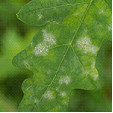
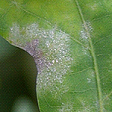 White powdery area
White powdery area 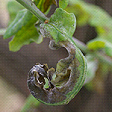
Symptoms
Powdery mildew (Oidium species) affects the following five plant groups with slightly different characteristics.
Cucurbits firstly form white spots on the underside of the leaves. Under optimum conditions the fungus spreads to the upper surface covering the entire leaf causing it to die. It may also extend to the stems slowing the growth of the plant and may reduce the size of the fruit.
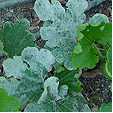
Grape leaves, flowers and fruit are attacked with the appearance of greyish-white powdery spots. Infected flowers set poor quality fruit and infected fruit splits open and dries out.
Pawpaw leaves become infected on the underside at first then spreading covering the entire leaf. The fruit forms irregular light grey spotted areas that damages the surface and under the surface causing the fruit to misshapen and reducing its market value.
Rose leaf and buds are covered in a fine white powdery coating and in severe cases it extends to the stems. When young leaves are infected they become distorted and older leaves develop blackened areas. Infected flower buds may fail to open and opened blooms may be discoloured or distorted.
Strawberries show different signs of infection with the leaf margins first rolling upwards then developing purplish irregular blotches along the veins. The infected flowers may fail to set fruit and if fruit is produced it is small, hard fails to ripen. Semi mature fruit that is infected has dull appearance and may form cracks or split open.
The Powdery Mildew (Sphaerotheca lanestris) infects leaves and twigs. The under side if the leaf firstly has a white mealy growth that matures to felt-like brown mycelium that can cover the entire leaf, and the twig tips. It is only one of the many types that infect Quercus species.
Source and Dispersal
The spores overwinter in fallen leaves, dormant buds, seed and infested plants. It is dispersed by wind.
Favoured Conditions
Generally it prefers warm humid conditions, but failing to germinate when it is raining. The fungus that attacks Pawpaw prefers cooler conditions disappearing in the warmer months.
Affected Plants
There are many plant species ornamental trees and shrubs that are attacked by Oidium species including; Roses, African Violets, Cucurbits, Grapes, Pawpaw, Strawberries, Hydrangeas, Ajugas, Antirrhinum, Oaks and Photinias.
Acer species are infected by the powdery mildews (Uncinula circinata) and (Phyllactinia corylea) but are not normally serious.
Aesculus species are infected by the powdery mildew (Uncinula flexuosa) which forms a white mold on the underside of the leaves.
Arenaria,Cuphea, Erica and Eschscholtzia species are infected by the powdery mildew (Erysiphe polygoni). This fungus is greyish or white and covers leaves or young shoots. Heavenly infected leaves turn brown and fall from the plant. The plant eventually dies.
Aster species are infected with the powdery mildew (Erysiphe cichoracearum) which is more prevalent on the lower part of the plant.
Ceanothus, Corylus, Platanus, Syringa and Weigela species are infected by the powdery mildew (Microsphaera alni) particularly London Plane. The mycelium forms a felt-like cover on the leaves.
Celtis species are susceptible to the powdery mildew (Uncinula parvula) and (Uncinula polychaete). This fungal problem can affect either side of the leaf, which can have spots or be completely coved in mildew. The fruiting bodies appear on the opposite side of the mildew.
Cornus species leaves are infected by the powdery mildew (Microsphaera alni) and (Phyllactinia corylea), covering the leaves in a whitish fungus.
Dahlia species are infected by the powdery mildew (Erysiphe cichoracearum) that forms white powdery areas on the leaf surface.
Lagerstroemia species are infected by the powdery mildew (Uncinula Australiana) that forms white powdery growth on the leaves and may also distort the infected foliage.
Populus and Salix species are infected by a white powdery mildew (Uncinula salicis) that produces black fruiting bodies with a curled tip, but is not normally a major problem.
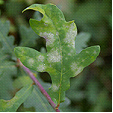
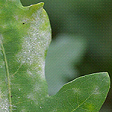 Quercus robur
Quercus robur
Quercus species are susceptible to several powdery mildew fungi including (Sphaerotheca lanestris), (Erysiph trina) and (Phyllactinia corylea). Generally white mealy growth appears on the leaves, normally on the underside turning the infected areas brown and then the leaf dies. The infection may spread to the twig tips causing dieback. Control may be difficult and unwarranted on large trees but nursery stock may be sprayed with a fungicide during susceptible periods.
Rosa species are also infected by the powdery mildew (Sphaerotheca pannosa).
Rudbeckia and Senecio species are covered in white fungus (Erysiphe cichoracearum) which infects leaves, flowers and stems. This results in the plant becoming stunted.
Senecio species are infected by the powdery mildew (Sphaerotheca fuliginea) which forms circular white powdery areas on the leaves.
Spiraea species are infected by the Powdery Mildew (Microsphaera alni) and (Podosphaera oxyacanthae).
Ulmus and Rhododendron (Azalea) species are also infected by (Microsphaera alni). Circular patches of white powdery growth appear on the leaves.
Veronica species are sometimes infected by the powdery mildew (Sphaerotheca humili) causing a white coating to appear on the leaves. Not normally a major problem.
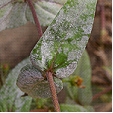
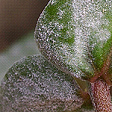
Zinnia elegans are commonly infected by the powdery mildew (Erysiphe cichororacearum), which appears on both sides of the leaves as a greyish powdery cover and may be transmitted by seed.
Non-chemical Control
Choose less susceptible species and when planting space the plants to allow good air circulation. Avoid overwatering and try to keep the foliage dry. Affected plants may be dusted with powdered sulphur or sprayed with a milk mixture to discourage mildew. Vegetables that are infected with mildew should be removed and replaced with new young plants, as they are more resistant to infection.
Chemical Control
Prenatitive spraying during warm humid conditions using a suitable fungicide such as wettable sulphur, bitertanol, carbendazim, fenarimol and triforine helps control the problem.
Note
Always read the label for registration details and direction of use prior to application of any chemicals.
DISEASE
NAME
Phytophthora Rot
Phytophthora species
Pathogen Name
A number of Phytophthora species cause these diseases but the most important species in Australia is the cinnamon fungus, Phytophthora cinnamomi. This species is exotic to Australia and probably originated from south east Asia; it has probably been present in Australia for close to 200 years. Phytophthora are fungal-like organisms that are related to some protozoa and algae; they are microscopic and cannot be observed by the naked eye.
Description
There are many types of Phytophthora Rot but generally the disease affects the plant by causing a soft rot of the affected plant part. The most common form of the disease is a rotting of the roots that occurs below ground with no visible symptoms of the disease above ground until the disease starts to cause leaf drop.
Symptoms
The disease is initiated below ground in the soil, usually on the feeder roots of a plant. The pathogen grows through the roots killing cells and eventually causing an extensive root decay. This causes the infected plant to lose vigour and the leaves to yellow and die. Entire branches starting from the top then die, quickly during hot weather or linger for months. The infection occurs on the root hairs causing small and large roots to rot. The symptoms of the disease are often very difficult to differentiate from drought symptoms, mainly because the affected root system prevents the uptake of moisture from the soil. Once the disease has progressed far enough large branches will die causing the typical dieback symptoms.
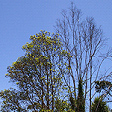
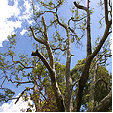
There are a number of other diseases caused by Phytophthora species
Twig Die Back (Phytophthora ilicis) attacks Ilex species causing black leaf spots and black stem cankers.
Phytophthora cactorum is known by several common names depending on which plant is being attacked and they have various symptoms. Plant species are listed below.
Root Rot (Phytophthora richardiae) infects Zantedeschia species causing the leaves to turn yellow, wilt and die. Flowers are deformed if they bloom and the infection can also be seen in the new growth, eventually killing the plant. On inspection the roots show signs of decay.
Stem Rot (Phytophthora cryptogea) infects the roots and stems turning them brown and seeds are also attacked causing decay. It is commonly found on Tagetes erecta and infected plants wilt, collapse and die.
Source and Dispersal
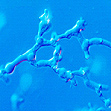 Sporangia
Sporangia 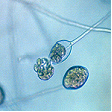 Zoospores
Zoospores 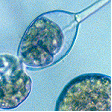
Image by Dr Brett Summerell
Phytophthora species produce sporangia that contain specialised zoospores that have flagella that allow them to move through the soil moisture small distances. These spores encyst on the root and then penetrate the root. The pathogen also produces chlamydospores, specialised survival spores that allow it to survive in the soil for extended periods of time. The chlamydospores can be transported in soil, even extremely small amounts, allowing the pathogen to be dispersed very easily throughout an area and from one location to another. The zoospores are easily moved in water flowing through soil and so are easily dispersed down slopes. It is not uncommon for the disease to move in fronts down a slope.

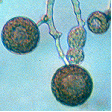 Chlamydospores, specialised survival spores
Chlamydospores, specialised survival spores
Image by Dr Brett Summerell
Favoured Conditions
Phytophthora root rot is favoured by poorly drained soils or in soils that are waterlogged for short periods of time. The disease generally occurs during periods when the temperature is above 16ºC although it has been observed in snow gum country in the Barrington Tops National Park and in southern Tasmania. It also prefers soils that have little organic material.
Affected Plants
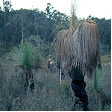
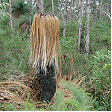 Xanthorrhoea species
Xanthorrhoea species
Image by Dr Brett Summerell
The host range that is attacked by Phytophthora cinnamomi is enormous and is still not well understood but includes many Australian native plants, Rhododendrons, Acer and Prunus species, conifers, cabbage tree and strawberries. Some Australian plant families that are quite susceptible include species in the Proteaceae, Epacridaceae and Xanthorrhoea species.
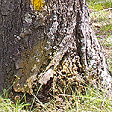 Alphitonia excelsa
Alphitonia excelsa
Alphitonia excelsa can be infected by Phytophthora cinnamomi causing loss of foliage, death of the upper branches and cankers on the trunk.
Cactus such as Cereus species may be infected with Slimy Collar Rot (Phytophthora cactorum) which forms a soft black area at the base of the plant that is water soaked.
Chamaecyparis species may be infected with the Root Rot (Phytophthora lateralis) that attacks roots, trunk, stems and leaves.
Cornus species are infected by Crown Canker (Phytophthora cactorum) and in this case the tree is partially infected initially with one side producing smaller leaves that turn reddish in late summer. The leaves may also shrivel and die prematurely, during dry periods and small and large branches die. After a couple of seasons the tree becomes completely infected with poor top growth and an inconspicuous canker develops at the base of the trunk. Eventually the tree dies.
Erica species are infected by (Phytophthora cinnamomi). The symptoms include foliage turning greyish towards the top, and then the plant wilts then dies with evidence of infection at the base.
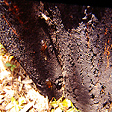 Phytophthora in Eucalyptus species
Phytophthora in Eucalyptus species
Image by B. Sonsie
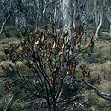
Image by Dr Brett Summerell
Eucalyptus species are infected by Phytophthora cinnamomi causing rapid die back of the tree with blackened trunk loss or upper growth and is a serious problem for certain species such as Eucalyptus diversicolor (Karri).
Euphorbia pulcherrima is susceptible to Root Rot (Phytophthora and Pythium species). Roots become dark and the rot can extend up the stem. The plant is also susceptible to leaf blight resulting from the same fungal disease.
Hedera species are infected by Phytophthora Blight (Phytophthora palmivora). This fungus causes leaf spots, foliage blight and stem rot.
Palms such as Archontophoenix, Caryota, Chamaedorea, Cocos, Dypsis, Howea, Liculia, Linospadix, Livistona, Phoenix, Ptychosperma, Rhapis, Roystonea, Syagrus, Washingtonia and Wodyetia species are also susceptible to Phytophthora Blight forming large irregular areas on the fronds that become dark and rotten and limited by the veins
Lilium species are infected by Foot Rot (Phytophthora cactorum) which attacking the stems just below the soil level causing the plant to topple and if infection occurs as the leaves are emerging the base of the infected leaves which collapse remain attached to the bulb.
Morinda citrifolia is infected by Phytophthora Blight, black flag disease (Phytophthora species) which causes the foliage to turn black and limp. The fruit and stems are also infected causing them to turn brown-black and whither.

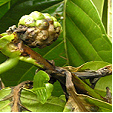 Morinda citrifolia
Morinda citrifolia
Orchids such as Cattleya, Cymbidium, Cypripedium, Dendrobium, Epidendrum, Paphiopedilum, Phalaenopsis and Zygopetalum species are infected by Black Rot (Phytophthora or Pythium species). This causes the leaves, pseudobulbs, rhizomes and roots to form a dark soft rot, normally occurring towards the base of the plant.
Saintpaulia, Dianthus, Gypsophila, Limonium and Anemone species are infected by Root and Crown Rot (Phytophthora nicotianae). This is a fast moving fungus that turns the roots blackish then extends to the crown and petioles causing wet rot of the crown then wilting, eventually killing the plant. When found as Phytophthora Leaf Spot or Blight, angular spots appear with water-soaked margins as in Cordyline and Philodendron species.
Sedum species can be infected by up to three Stem Rot fungi including (Colletotrichum species), (Phytophthora species) and (Pellicularia filamentosa). Commonly occurring in wet soils.
Ulmus and Acer species are also infected by (Phytophthora cactorum) and this is known as Bleeding Canker. This casual disease initially causes cankers in the bark that ooze sap and the sapwood forms reddish lesions with greenish margins. The leaves on affected branches turn yellow, wilt then die and mildly affected trees may survive.
Many species are infected by the Bleeding Canker including Acer platanoides, Acer rubrum, Acer pseudoplatanus, Acer saccharinum, Betula species, Liquidambar styraciflua, Aesculus x carnea, Tilia, Salix and Quercus species.
Non-chemical Control
The most effective control for all Phytophthora diseases is prevention primarily because it is extremely difficult to control Phytophthora diseases after they are established in the plant. As Phytophthora species are most easily transported in infested soil quarantine is an essential component of control of the disease and it is for this reason many areas have hygiene protocols to stop the pathogen being introduced into an area. It is recommended that bush walkers take care not to introduce the pathogen on their boots into un-infested areas and for this reason it is suggested that walking boots be cleaned and preferably sterilised (with 70% methylated spirits) prior to starting a walk.
Cultural techniques such as cultivating the soil regularly with added animal manure and other organic substrates to ensure there is good drainage will also help to minimise the impact of the disease. The plants can be mulched with straw or other organic material taking care that the base of the trunk is left clear. Avoid over watering the soil and observe hygiene in regards to tools, containers or shoes to reduce spreading the infection.
Potting mixes should be pasteurised for 30min at 60ºC to ensure that they are free of the pathogen. It is also very important to grow pots off the ground to prevent the splash of infested mix or water from an infected plant to clean plants.
.
Avoid damaging the bark particularly at ground level and seal any wounds that occur. If cactus or tree species are infected it is possible to cut out the infected area when first seen in order to contain it. Correct tree surgery techniques are required for large trees.
Chemical Control
There are a number of fungicides that are registered for use in the control of these diseases. The most effective chemical control are based on the use of chemicals containing potassium phosphonate. This chemical effectively enhances the defence systems of the plant and has been shown to be most effective in controlling Phytophthora diseases. It is essential that the chemical be applied when the plants is exporting nutrients to the roots, so this is best in the warmer months. The chemical can be applied as a stem injection or a foliar spray, and in some situations as a soil drench. There are specialised stem injecting equipment available for stem injections on larger trees.
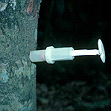
Image by Dr Brett Summerell
Note
Always read the label for registration details and direction of use prior to application of any chemicals.
Amendments by
Dr Brett Summerell
Director Science and Public Programs
Royal Botanic Gardens Trust, Sydney
Average Lowest Temperature : -1º C 30º F
USDA : 9, 10, 11
This USDA (United States Department of Agriculture) hardiness zone chart can be used to indicate a plant’s ability to withstand average minimum temperatures. However, other factors such as soil type, pH, and moisture, drainage, humidity and exposure to sun and wind will also have a direct effect on your plant’s survival. Use this chart only as a guide, always keep the other factors in mind when deciding where, when and what to plant.
A plant's individual USDA zone can be found in the Plant Overview.
Climate Description
Warm to Sub-tropical
This overlaping zone has ample rain with high summer temeperatures and high humidity. Winters are mild. Pockets of sub-tropical climates exist within coastal warm temperate zones.
Frosts and droughts rarely occur along the coast.
Plant growth
Tropical and warm temperate native and exotic plants grow well.
| Dictionary | Growth Habit |
| Leaf Type | Botanic Flower Description |
| Leaf Shape | Flower Inflorescence |
| Leaf Arrangement | Fruit Type |
| Leaf Margin | Bark Type |
| Leaf Apex And Bases | Flower Description |